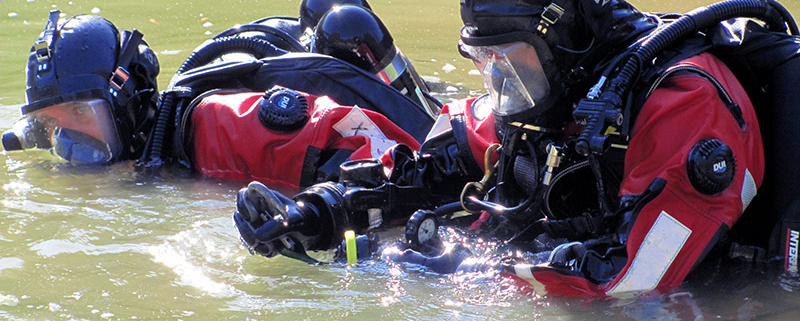3 Things to Keep Your Public Safety Dive Team Safe
by Dr. Thomas W. Powell:

Understanding the Environment
Understanding the environment in which a public safety dive team operates is critical. Every ERDI public safety course starts by telling students to “size up” a scene and take note of important information. This information may include objects such as vehicle wreckage or dangerous entry points, or even problematic odors such as the scent of fuel or dangerous gasses. If divers cannot prep and perform in a safe fashion, the associated mission is likely to grow problematic or unsafe.
Similarly, divers are taught to obtain information from outside resources and even witnesses to better understand a dive environment. A witness may help to focus a search area, while a local may know the bottom features of a body of water. Fishermen often know where lines get snagged or boats have trouble. If a witness can help narrow a search area, the divers will have a reduced area to cover which may reduce diver exhaustion and the total time underwater. If a local can provide information, a team leader may be better prepared for planning the proper search patterns or team resources to overcome possible hazards that were otherwise unknown.
Finally, public safety divers are taught to obtain information about water quality. This information may come from local labs, state facilities, or even the Environmental Protection Agency. This information can be filed and maintained to ensure that when a team deploys, as much data as possible is available to determine if a dive operation should be performed. Knowing the quality of water in a specific location may help a diver plan what equipment and support resources are needed. This knowledge may also help to show the need for resources maintained at differing departments (such as a HAZMAT team) to be made available on the scene of a dive.
Risk vs. Benefit
In regard to risks versus benefits, all forms of diving involve some level of risk analysis. A recreational diver must analyze possible depths, temperatures, personal health, and other factors to determine if a dive should be considered reasonable and safe on a satisfactory level. Public safety diving is no different other than to involve a greater set of risk factors. Team leaders and individual divers must determine if the lack of visibility, dangerous water quality, underwater hazards, and various other factors make a search worthwhile. For example, if a criminal has admitted to a crime, and other evidentiary factors have almost sealed a case for a prosecutor, the handgun lost in a swamp may not be worth seeking if the risk associated with harming a diver is too great.
Divers operating on public safety dive teams must recognize potential threats and safety concerns. Every diver is a dive safety officer when it comes to the safety of his/her self and others. If entries are too dangerous, another route must be planned. If the water quality is too poor and dry suits are not available, the team must decide not to dive. No item, weapon, or remains, is worth the life of a healthy public safety diver. All divers accept risks when they choose to entertain the sport of scuba diving. Despite this, a team or dive organization must remember that liability is a constant issue when the safety of others is in question. The reality is that a team and its members must determine what level of risk they consider to be safe (following historical and data-based guidance), and work together to not violate this limitation. Finding a missing item is a success for any dive team, but the family members of an injured diver may not recognize any level of success over the injury.
Having the Right Equipment
Finally, a dive team must have and maintain proper equipment for the missions in which the team may choose to participate. ERDI divers are taught that all dives should be considered to involve contaminated water unless definitive proof shows otherwise. This education suggests that divers operating within public safety parameters should be fully encapsulated with dry suits, fitted and attached hoods, full-face masks, and attached gloves and boots. The equipment used by dive team members should also be standardized to ensure that every team member knows where items are placed and how to assist one-another during an emergency. Similarly, a diver should never be required to bail out of his or her mask if at all possible. For this reason, switch blocks become essential to allow a diver to switch to backup gasses as needed. The lines used to connect divers to tenders must be sturdy and rated to handle contact with sharp objects underwater. In regard to secondary search equipment, metal detectors or sonars can reduce search times, decontamination equipment ensures a higher level of individual safety, and even items like cylinder stands can ensure increased comfort and safety when dealing with diver exhaustion during decontamination.
A dive team must be prepared to provide to its divers the equipment that they need. Once this equipment is possessed, it must be maintained and serviced on a regular basis. When equipment is subjected to the worst possible environments, service is critical to prevent possible failures.
If a dive team seeks to understand its operational environment, maintains proper equipment, and ensures the benefits of an operation outweigh the risks, that team is more likely to experience success and higher levels of diver safety. Safety should be the first concern of any dive team. No operation is worth the lives of team members, and the risks associated with public safety dive operations must always be recognized and monitored to the highest degree possible.
-Dr. Thomas W. Powell
Owner/Instructor Trainer – Air Hogs Scuba, Garner, NC



Leave a Reply
Want to join the discussion?Feel free to contribute!